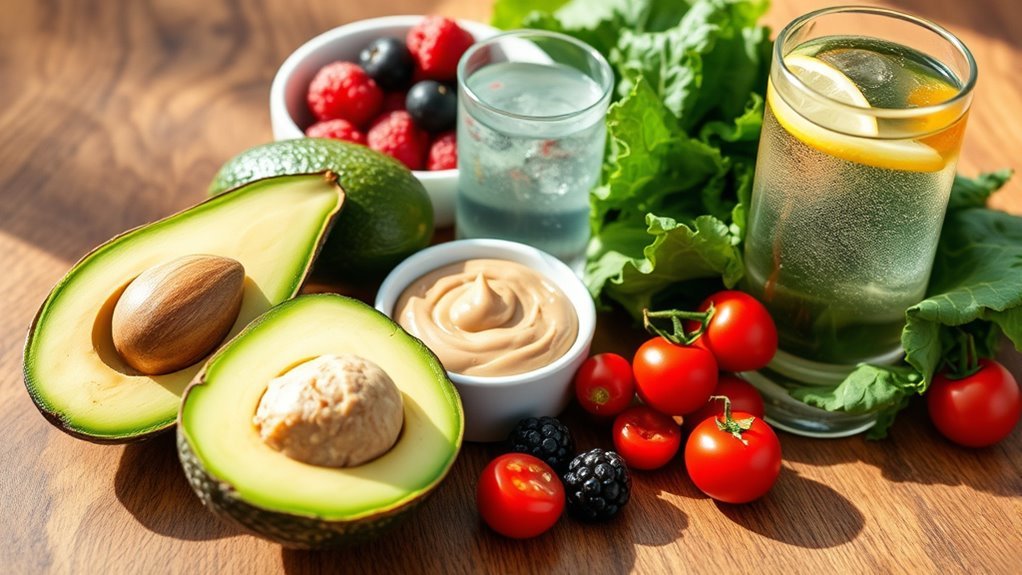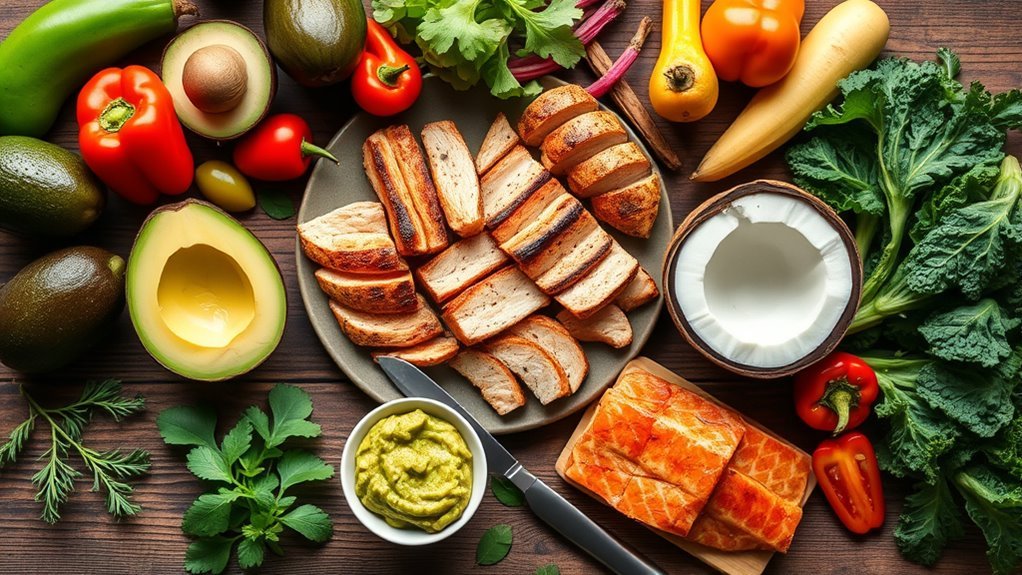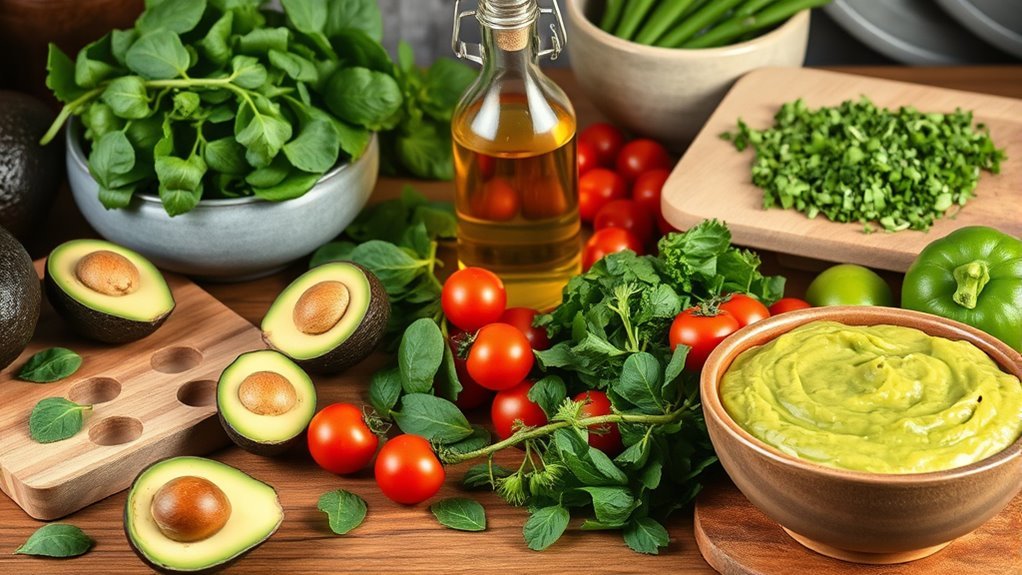To start a ketogenic diet, focus on high-fat, moderate-protein, and low-carb foods. This encourages your body to enter ketosis, where it burns fat for energy. Prioritize healthy fats like avocados and olive oil, and include low-carb vegetables such as spinach and broccoli. Avoid grains and sugars to prevent disrupted ketosis. Planning meals and tracking your food intake can aid in success. If you want to explore more strategies and tips, there’s plenty more to uncover.
Understanding the Basics of the Ketogenic Diet

When you immerse yourself in the ketogenic diet, it’s essential to grasp its fundamental principles, as this understanding will guide your journey toward effective weight management and improved metabolic health. The ketogenic diet emphasizes high-fat, moderate-protein, and low-carbohydrate intake, pushing your body into a state of ketosis. In ketosis, your body burns fat for fuel instead of glucose, yielding several ketosis benefits, such as increased energy levels and appetite suppression. However, to achieve these benefits, you’ll need to adhere to specific dietary restrictions, avoiding high-carb foods like grains and sugars. Balancing your meals with healthy fats, like avocados and nuts, will enhance your experience while allowing you the freedom to explore new culinary options within these guidelines.
The Science Behind Ketosis

Ketosis, which occurs when your body shifts from burning carbohydrates to burning fat for energy, is a fascinating metabolic state with significant implications for weight loss and overall health. In this state, your liver converts fatty acids into ketones, which serve as an alternative fuel source. Understanding the ketosis mechanisms can empower you to harness fat stores effectively, promoting fat loss and improving energy levels. This metabolic state also has potential benefits for mental clarity and reduced hunger, allowing for a more liberating experience in your dietary choices. By embracing ketosis, you can experience not just weight loss, but a shift in how your body processes energy, ultimately paving the way for a healthier lifestyle.
Essential Foods for a Keto Diet

To successfully begin a keto diet, it’s crucial to focus on the right foods that will help maintain ketosis and support overall health. Prioritize essential fats like avocados, olive oil, and fatty fish, as they provide the necessary energy while keeping carbs low. Incorporate low-carb vegetables such as spinach, kale, and broccoli to guarantee you get your vitamins and minerals. When you need a quick bite, consider keto snack ideas like nuts, cheese, or hard-boiled eggs to keep your hunger at bay without spiking your blood sugar. Remember, the key to a successful keto journey lies in selecting nutrient-dense foods that align with your dietary goals while enjoying the freedom of delicious flavors.
Meal Planning Tips for Success
To successfully implement a keto diet, effective meal planning is essential. You should start by planning weekly menus that focus on keto-friendly foods, ensuring you have the right ingredients on hand. Additionally, prepping meals in batches can save time and help you stay on track with your dietary goals.
Plan Weekly Menus
Planning weekly menus is a crucial step in successfully adopting a keto lifestyle. By organizing your meals, you can guarantee meal variety while maintaining portion control, two essential factors for success on this diet. Start by selecting recipes that excite you and fit within your macro goals. Incorporate different protein sources, healthy fats, and low-carb vegetables to keep meals interesting and satisfying. Consider batch cooking to save time during the week, allowing you the freedom to enjoy your meals without the daily stress of planning. Don’t forget to adjust portions based on your activity level and personal needs. By thoughtfully planning your menus, you’re setting yourself up for a sustainable and enjoyable keto journey.
Stock Keto-Friendly Foods
Stocking your kitchen with keto-friendly foods is essential for meal planning success. By having the right ingredients on hand, you’ll find it easier to create satisfying meals and snacks that align with your low-carb lifestyle. Here’s a list of must-have items:
- Healthy Fats: Avocados, olive oil, and coconut oil provide energy and flavor.
- Low-Carb Vegetables: Spinach, kale, and zucchini keep your meals nutrient-dense.
- Proteins: Eggs, chicken, and fatty fish offer essential amino acids.
- Keto Snacks: Nuts, cheese, and beef jerky can help curb cravings.
With these staples, you’ll have the foundation for delicious, low-carb meals that keep you energized and focused on your keto journey. Enjoy the freedom that comes with planning!
Prep Meals in Batches
Preparing meals in batches can greatly streamline your keto journey, as it not only saves time but also guarantees you have nutritious options readily available. Batch cooking is an effective way to adhere to your meal prep strategy, allowing you to maintain variety without the daily hassle.
| Meal Type | Example Dish | Preparation Method |
|---|---|---|
| Breakfast | Egg muffins | Bake in muffin tin |
| Lunch | Zucchini noodles | Sauté with sauce |
| Dinner | Cauliflower rice stir-fry | Stir-fry and portion out |
Navigating Keto Grocery Shopping
When you’re grocery shopping for a ketogenic diet, knowing which essential food items to prioritize can make a significant difference. It’s also vital to read nutrition labels carefully to guarantee you’re choosing options that align with your dietary goals. Additionally, there are budget-friendly keto choices available that can help you maintain your lifestyle without overspending.
Essential Keto Food Items
Maneuvering the grocery store for keto-friendly food can be overwhelming, especially with a myriad of options available. To simplify your shopping, focus on these essential keto food items that provide healthy fats and satisfying keto snack options:
- Avocados – Packed with monounsaturated fats and fiber.
- Nuts and Seeds – Almonds, walnuts, and chia seeds are great for snacking.
- Coconut Oil – A versatile fat source for cooking and baking.
- Non-Starchy Vegetables – Spinach, broccoli, and cauliflower are low in carbs and nutrient-rich.
Reading Nutrition Labels
Understanding how to read nutrition labels is a key skill for anyone following a keto diet. When you’re traversing grocery aisles, focus on total carbohydrates, fiber, and net carbs. Net carbs are calculated by subtracting fiber and certain sugar alcohols from total carbs, as they have minimal impact on blood sugar. While reading labels, pay attention to serving sizes, since they can skew your understanding of a product’s carb content. Additionally, understanding ingredients is essential; look for whole foods and avoid hidden sugars or starches. Familiarize yourself with common keto-friendly ingredients like almond flour or erythritol. By mastering reading labels, you’ll empower yourself to make informed choices that align with your keto lifestyle, enhancing your sense of freedom.
Budget-Friendly Keto Choices
How can you navigate the grocery store while sticking to a budget on a keto diet? It’s possible to enjoy delicious meals without breaking the bank. Here are some tips for budget-friendly keto choices:
- Plan Your Meals: Create a weekly meal plan to avoid impulse buys.
- Buy in Bulk: Stock up on affordable snacks like nuts and seeds, which are low in carbs.
- Focus on Whole Foods: Choose fresh vegetables, meats, and eggs, which often have a better price-to-nutrition ratio.
- Budget Meal Prepping: Prepare meals in advance to save time and money, reducing the temptation to eat out.
Common Mistakes to Avoid
While starting on a keto diet can be rewarding, it’s crucial to recognize and avoid common pitfalls that may hinder your progress. One major issue is falling prey to keto myths, such as believing you can eat unlimited fats without considering overall calorie intake. This misconception can lead to weight gain instead of loss. Additionally, not tracking your carb intake accurately can keep you from reaching ketosis. Another common pitfall is neglecting hydration and electrolytes, which can cause fatigue and discomfort. Finally, avoiding a variety of foods may lead to nutrient deficiencies. By staying informed and mindful of these common mistakes, you can navigate your keto journey more effectively and achieve the freedom you desire.
Staying Motivated on Your Keto Journey
Maneuvering the keto diet can be challenging, especially when faced with common mistakes that may derail your efforts. Staying motivated is essential, and here are some effective strategies to take into account:
- Set Clear Goals: Define what success looks like for you and establish short-term and long-term objectives.
- Engage in Community Support: Join keto groups for shared experiences and encouragement, fostering a sense of belonging.
- Find Accountability Partners: Pair up with someone who shares your goals; this can boost motivation and accountability.
- Implement Reward Systems: Celebrate milestones with non-food rewards to reinforce positive behavior.
Embrace mindset shifts and prioritize progress tracking. Remember, motivation is a journey, and with the right support, you can achieve your keto goals.
Tracking Your Progress and Adjusting Your Approach
As you commence your keto journey, tracking your progress is essential for understanding what works and what doesn’t. Utilize progress metrics, such as weight, body measurements, and ketone levels, to gauge your success. Regularly recording these metrics not only shows you how your body responds but also helps identify patterns over time. If you notice stagnation in weight loss or energy levels, consider adjustment strategies. This might include tweaking your macronutrient ratios, experimenting with meal timing, or increasing physical activity. Remember, flexibility is key; what works for one person may not work for you. Embrace the freedom to adapt your approach as needed, ensuring your keto journey remains personal and effective. Stay informed, and make adjustments that align with your goals.


